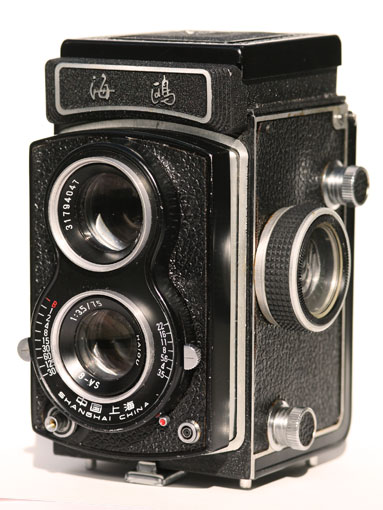
 |
|
Imported in France during the early 70's by the CCI company, the Seagull 4A
is a nice TLR (Twin Lens Reflex) produced in Shanghai, China by the Shanghai Seagull Camera Ltd.
The series Seagull 4 appears during 1967
while the cultural revolution is still the sad reality of China. The
model 4A will be the first evolution
available
starting 1968. Then, a more professional version will be proposed : the
Seagull 4A-1.
Later on, two simplified versions of the 4A will be available: the
Seagull 4B
and 4B1. Last but not least, a version using a film 135 will be marketed
as the model 4C which is quite rare today. |
|

Seagull 4A (1968) |
When marketed,
the sale price of a Seagull 4A was equivalent
to the annual salary of a Chinese worker.
In such a context, no need to say
that its main clients were the
dignitaries of the communist party and
some accredited journalists.
Even more expensive,
the 4A-1 (the
professional
version of the 4A)
was an export
product.
As a result, this variant lost its two chinese characters visible on the
front of the 4A model. These ones were replaced by the label "SEAGULL"
written
in Roman characters.
This camera seems to be robust.
However, it must be not compared to a Rolleiflex or a Rolleicord (Franke &
Heidecke would turn in their graves
if you do it!).
Of course, it has
almost
the same
dimensions,
the
same
weight and ergonomics. But if you look at it carefully, you will notice
that the quality of its components and its finish are not exactly the
same as their Germain cousins.
 |
The optical lens is a Hiaou f/3.5 - 75 mm with 3 lens; the view
lens is a f/2,8 - 75 mm. |
 |
The shutter
offers a speeds range of
1s up to 1/300eme with pause B and Synchro X. |
 |
The speed selector can be done with a cursor located on the left of
the lens. |
 |
Another cursor located on the right of the lens is used to select the
aperture. |
 |
The viewfinder is the same as on a Rolleiflex or a Rolleicord. |
 |
As on the Rolleiflex Automat,
the shutter reload and
the
film advance are
coupled.
Both actions are done simultaneously when rotating the handle located
on the right of the camera. |
 |
However, the
big button located on the left hand side of the camera body in not a
photoelectric cell as with a
Rolleiflex T
but table giving the depth of field according to the selected
aperture. |
The
Seagull 4A
uses a
film 120
producing
negatives of 6 x 6 cm
format. |
|
 This
camera, which is quite rare in Europe, arrived straight from China is
the bags on my friends Jean-Marc et Anna. Considering the weight and the
size of this camera as well as the frenetic habit of Anna to fill any
empty space of her luggage, I'm twice grateful to them for having
offered me this camera. This one was found in a little flea market. This
camera, which is quite rare in Europe, arrived straight from China is
the bags on my friends Jean-Marc et Anna. Considering the weight and the
size of this camera as well as the frenetic habit of Anna to fill any
empty space of her luggage, I'm twice grateful to them for having
offered me this camera. This one was found in a little flea market.
As a matter of fact, the Chinese cultural revolution
had at least one positive consequence. Thousands of cameras and musical
instruments (see the extraordinary movie 'The red violin') were hidden
between 1960 and 1969. As a consequence, they have been preserved of
time and this is why it is still possible to discover today in China so many
old cameras in pretty good shape. |
Nombre
de visiteurs
Number of visitors |


![]()
